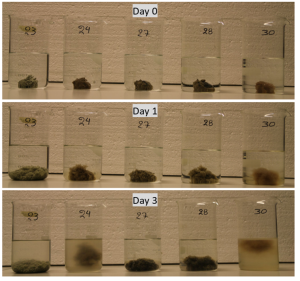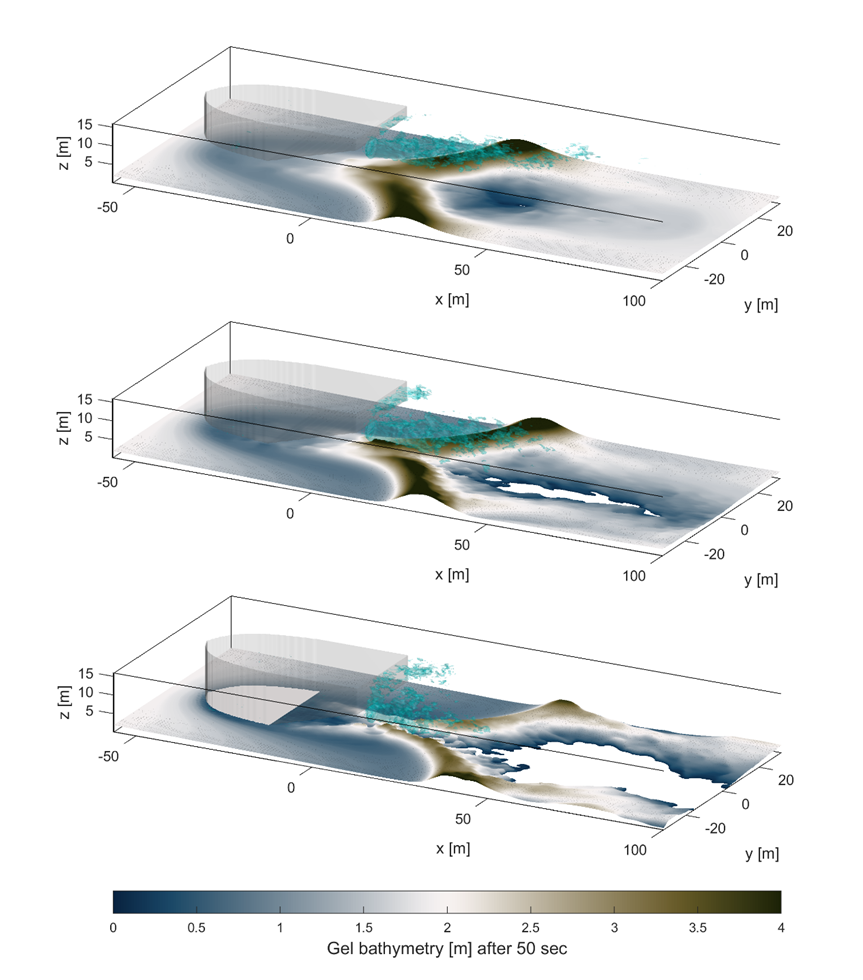
Dredging efforts in the Port of Rotterdam are associated with high yearly costs and emissions. Furthermore, the presence of contaminated sediments in ports may enhance the complexity of these dredging operations. In TKI project DEL 137 GELINPORTS it is studied whether gel barriers can be used to tackle these challenges. The TKI consortium consists of the Port of Rotterdam (PoR), Rijkswaterstaat (RWS), TU Delft, Royal HaskoningDHV, SmartPort and Deltares.
The research within TKI project GELINPORTS has been split in two phases:
Gel barriers are intended as biodegradable obstacles which could be placed on the bottom of a port entrance to reduce the spreading of sediments into certain port areas (Figure 1). Gel barriers are a combination of dredged material (i.e., excess sediment) and a biological flocculating agent, which should result in a stable yet eco-friendly barrier. Several types of flocculants will be tested. One of the potential candidates is Kaumera Nereda® Gum, which is a new bio-based raw material that is extracted from the sludge granules that form during the Nereda® purification process.
In particular for inland harbors, where dredging is associated with long sailing distances to the offshore disposal sites, gel barriers might be useful to lower dredging costs and emissions. This is especially true if sediment that would otherwise settle in a harbor basin settles closer to the river mouth (and thus the offshore disposal site). A gel barrier could also be used to keep contaminated sediments from spreading into specific port areas if they are concentrated near the bottom (see right panel Figure 1). A gel barrier should be sufficiently stable to endure the flow conditions in the Port of Rotterdam, while it should not obstruct navigation for vessels. A barrier should be sufficiently durable and/or cheap such that the dredging savings outweigh its material, production, placement and maintenance costs and/or emissions.

Figure 1: Intended operation of a gel barrier. Left: sediment intrusion in the Botlek and 3rd Petroleum harbor without (top) and with a gel barrier (bottom). Right: small scale experiment which illustrates how a gel barrier, constructed with Calandkanaal mud and Xanthan gum, could stop a sediment density currents. Figures are from Bampatzeliou et al. (2022).
Phase 1 Design stable gel
Bampatzeliou et al. (2022) tested different gelation agents and found that the gel stiffness of the final product can be tuned by adjusting the concentration of solids and gelation agent in the final recipe. Gels with shear stress from 80-5,000 Pa can possibly be developed by mixing mud from port of Rotterdam with a gelation ingredient. Kaumera with the current low concentration of solids does not provide sufficient strength to build a barrier. A more appropriate application would be as an eco-friendly flocculent as it is seen that dried Kaumera can increase flocculation rates in diluted clay suspensions. Xanthan Gum, a polysaccharide polymer, has promising properties for the application of a gel barrier in terms production costs/effort, stability and durability. Xanthan Gum (XG) is readily used on large scale in the food industry and even in dyke projects as a stabilization agent for soil. By mixing local mud from the port with small quantities of XG (0-3% mass) a wide range of Bingham Yield Strengths can be realized (0-400 Pa) by varying the solids and/or XG content. Three gel examples with XG are summarized in the table below.
Name | Bingham Yield Strength (BYS) [Pa] | Bulk density [kg/m3] |
XG3Mud20 | 400 | +/- 1200 |
XG1Mud10_v1 | 200 | +/- 1100 |
XG1Mud10_v2 | 100 | +/- 1100 |
A 100 Pa gel represents a gel that would not obstruct navigation if a vessel would sail into the barrier. Based on experiments in several ports around the world, it was found that fluid mud layers with densities up to 1200 kg/m3 remain navigable. Furthermore, the German port of Emden prescribes that fluid mud is navigable up till 100 Pa (Kirichek, et al., 2018). XG1Mud10_v2 has properties within these limits (Table 2‑1). The 400 Pa gel (XG3Mud20) represents a material that could be used in locations where more strength is required, and where the draught of vessels is not limited. Bampatzeliou et al., (2022) showed that the gel’s strength is time-dependent and some swelling and weakening over time can be expected, although this influence will be stronger in lab-scale as in field-scale.

Figure 2: Example of different tested gels
Three application concepts have been evaluated, the batch preparation, the in-line application approach and the concept of the premade gel barrier. With respect to the time required for applying the product, a barrier in the port can be made with all concepts within 4 hours. The application method with the lowest generation of CO2 emissions is the inline concept, where mud is dredged- mixed with xanthan gum and placed underwater in a continuous mode. This reduced the energy required for transportation and thus CO2. At the end of its life the barrier can be reused to support dykes which can enhance the circularity of the product. Rebuilding the barrier on the same location is expected to still be possible even without prior barrier removal.

Figure 3: Three application concepts of a gel barrier
Phase 2 Analysis of the hydrodynamics, sediment transport and stability of a gel barrier
Based on lab experiments and numerical simulations, it can be concluded that the inland harbors of the PoR – such as Botlek – are most suitable to construct a barrier in terms of gel stability and the gel barrier’s potential to reduce sedimentation. In inland harbors the flow conditions are generally mild, so that a gel barrier can withstand the natural flow currents and the water column is stratified which enhances its ability in steering sedimentation.
Lab experiments are used to approximate the gels’ erosion thresholds. A 100 Pa BYS (Bingham Yield Stress) gel, which is expected to be navigable, does not erode for near-bottom velocities below 0.6 m/s. This gel is most suitable to construct a barrier in the more sheltered areas in the port like the entrances of Botlek/3e Petroleumhaven, Waalhaven and the Calandkanaal, where the tidal and river flow induced bed shear stresses remain below the gel’s erosion threshold. For the parts of the port with stronger currents, the stiffer 400 Pa BYS gel might remain stable as its erosion threshold is expected to be > 1 m/s. It is however the question whether such a stiff gel is navigable.
Apart from the ambient conditions also propeller jets of passing vessels affect the gel’s stability. The propeller jet impact on a gel barrier is investigated by using CFD simulations. The propeller jet of a representative large vessel that is expected to sail into Botlek several times per week is found to inflict velocities on the gel barrier which are higher than the 100 Pa gel’s erosion threshold when the gap between keel and gel barrier is below 2 m. In those situations, damage to the gel barrier is expected to occur. It requires further research to investigate how effective a gel barrier is after a large vessel has passed with its keel close to the gel barrier and how a gel barrier could be maintained after such event.

Figure 4: CFD simulations of the non-Newtonian rheological gel response to a passing ship with propeller (three different gaps between keel and top gel barrier 4m, 2m and 0m)
The results of a large-scale sediment transport model suggest that the barrier is most effective in reducing sedimentation in the inland harbors with little vertical mixing and thus a concentrated near-bed layer of suspended sediment. Of the investigated locations, the barrier was found to be most effective in the Botlek/3Pet basin, where the sedimentation rate is reduced with roughly 17% for a 3 m-high barrier. Most of this sediment mass (80%) settles within 15 km from the Botlek in the main waterways/rivers, 15% of which can be found landward leading to extra sailing distance for the dredger and 65% seaward leading to a reduction in sailing distance. Although this study does not quantify the potential saving in terms of costs or CO2 emissions, these results suggest that a barrier could benefit dredging operations.
Conclusions and recommendations
All in all, the gel barrier has a very attractive combination of features. It can limit and steer sedimentation and as material it has some strength while being flexible at the same time. The gel barrier has the potential to reduce dredging efforts (and, hence, costs and emissions), by reducing sailing distances and reducing dredging operations in less accessible and potentially contaminated basins. This applies especially to the inland harbors, such as the Botlek. Gel barriers are especially effective in stratified systems and the effectiveness increases with a barrier height of more than 2m.
The most important knowledge gaps are the costs of the gel barriers vs its benefits as well as the stability of the barrier in time under different failure mechanisms and the question of gel barrier effectiveness and required maintenance after ship propeller damage. Gel could also be applied for other applications as studied here, for example in a sediment trap to increase the sediment density, near dry docks, in an approach channel or near a quay wall which is a spot difficult to dredge, or to contain contaminated sediment within a confined area. However, before a field pilot may be carried out, there are still several open questions that need to be addressed first.
This TKI project served as a feasibility study on the application of gel barriers in a port. It is recommended to continue with follow up research along different lines:
It is logical and a relatively limited effort to start with line 1. When line 1 is finished lines 2 and 3 could be done simultaneously as there are interactions between them. When lines 1-3 are completed then it is recommended to start line 4 which is a small-scale pilot field test to learn in practice.
Our products are: